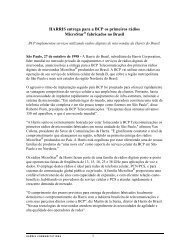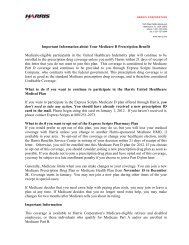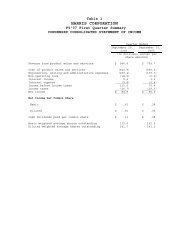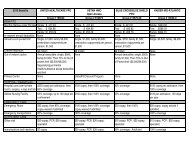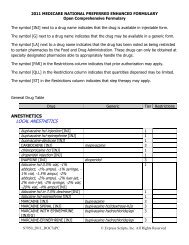METHOD OF ALLOCATING MULTIPLE ASYNCHRONOUS DATA ...
METHOD OF ALLOCATING MULTIPLE ASYNCHRONOUS DATA ...
METHOD OF ALLOCATING MULTIPLE ASYNCHRONOUS DATA ...
You also want an ePaper? Increase the reach of your titles
YUMPU automatically turns print PDFs into web optimized ePapers that Google loves.
this list into descending unallocated space order. Following<br />
the sorting of the channel fragment list, the protocol<br />
will iterate over the list of channel fragments and allocate<br />
the fragment to the compound service, from the reserved<br />
service list, in which the difference between the residual<br />
channel space and the requested channel capacity is minimized<br />
(Figure 9). If at any time during the algorithm the<br />
allocation of an existing service fails, though unlikely in a<br />
well managed system, the Network Management System<br />
will deny the new service request, abort the process, and<br />
inform the system operator that a request was denied due<br />
to insufficient capacity.<br />
START<br />
RECEIVE A SERVICE<br />
REQUEST FOR AN ADT<br />
SERVICE THAT CAN<br />
NOT BE FULFILLED<br />
USING INITIAL<br />
ALLOCATION <strong>METHOD</strong>.<br />
CREATE A LIST <strong>OF</strong><br />
SERVICES THAT NEED<br />
TO BE ALLOCATED<br />
WITHIN A SET <strong>OF</strong><br />
CHANNELS.<br />
SORT THE SERVICE LIST<br />
INTO DESCENDING<br />
TIMESLOT SIZE ORDER.<br />
REALLOCATE ALL BUT<br />
THE N LARGEST<br />
SERVICES THAT CAN BE<br />
CONVERTED TO<br />
COMPOUND SLOTS.<br />
CREATE A LIST <strong>OF</strong> THE<br />
COMPOUND SERVICES<br />
THAT WERE NOT<br />
ALLOCATED.<br />
CREATE A LIST<br />
CONTAINING ANY<br />
CHANNELS WITH<br />
UNALLOCATED<br />
CHANNEL SPACE.<br />
SORT THE CHANNEL<br />
LIST INTO DESCENDING<br />
UNALLOCATED<br />
CHANNEL SPACE<br />
ORDER.<br />
ASSIGN CHANNEL<br />
FRAGMENTS TO<br />
SERVICES IN THE<br />
UNALLOCATED ADT<br />
SERVICE LIST.<br />
NO<br />
ARE THERE<br />
ANY COMPOUND SERVICES<br />
REMAINING THAT NEED<br />
CHANNEL SPACE.<br />
YES<br />
ALLOCATE REMAINING<br />
ADT SERVICES TO<br />
ADDITIONAL<br />
CHANNELS USING THE<br />
BEST FIT ALGORITHM.<br />
WAS THERE ENOUGH<br />
CHANNELS TO ALLOCATE<br />
NO<br />
REMAINING ADT<br />
SERVICES.<br />
NOTIFY THE OPERATOR<br />
<strong>OF</strong> SERVICE<br />
ALLOCATION ERROR.<br />
Figure 9: Compound Service Relocation Diagram<br />
Through the employment of the relocation algorithm the<br />
Network Management System is not only capable of utilizing<br />
compound services to make use of the residual channel<br />
space in an IW communications system, but the level of<br />
channel fragmentation is in fact improved by 4 - 5% over<br />
that of the initial service allocation utilizing the previously<br />
illustrated modified BF algorithm (Figure 10).<br />
Channel Fragmentation (%)<br />
35.00<br />
30.00<br />
25.00<br />
20.00<br />
15.00<br />
10.00<br />
5.00<br />
0.00<br />
0 10 20 30 40 50 60 70 80 90 100<br />
Percentage of Large Services<br />
Modified Best Fit w/ Relocation Modified Best Fit Initial First Fit<br />
Figure 10: Compound Service w/ Relocation<br />
Channel Utilization<br />
END<br />
Paper ID# 900150.PDF<br />
9. SUMMARY<br />
Through the use of the IW protocol it is possible to greatly<br />
improve the communications capabilities of the existing<br />
UHF MILSATCOM constellation by allowing more terminals<br />
to simultaneously utilize a single MILSATCOM<br />
channel than with the legacy DAMA protocol. Regrettably,<br />
the allocation of large timeslots and channel fragmentation<br />
hinders the ability of the Network Management System<br />
to efficiently and effectively allocate services and<br />
diminishes the benefits of transitioning from the legacy<br />
DAMA protocol to the state-of-the-art IW protocol. Fortunately<br />
the addition of the ADT service type empowers<br />
the Network Management System with the ability to allocate<br />
compound services and facilitates the usage of the<br />
residual channel fragments within an IW communications<br />
system. By utilizing a modified Best Fit and service relocation<br />
algorithm in the initial allocation and reallocation of<br />
compound services within an IW communications system,<br />
in conjunction with the employment of the new ADT service<br />
type, the Network Management System can overcome<br />
the aforementioned limitations to the IW protocol and improve<br />
the utilization of limited satellite resources by 10 -<br />
25% over that of a typical IW communications system.<br />
10. REFERENCES<br />
7 of 7<br />
[1] MIL-STD-188-183A, Department of Defense Interface<br />
Standard, “Interoperability Standard for 25-kHz<br />
TDMA/DAMA Terminal Waveform (Including 5-kHz and<br />
25-kHz Slave Channels),” 20 March 1998, U.S. DoD.<br />
[2] MIL-STD-188-181B, Department of Defense Interface<br />
Standard, “Interoperability Standard for Single-Access 5kHz<br />
and 25-kHz UHF Satellite Communications Channels,”<br />
20 March 1999, U.S. DoD.<br />
[3] Gary R. Huckell, Frank M. Tirpak, Edward W. Chandler,<br />
“A new layered protocol integrating 5-kHz and 25-kHz<br />
DAMA operations: A proposed improvement to the UHF<br />
DAMA standards”, MILCOM 1999 – IEEE Military<br />
Communications Conference, vol. 2, October 1999 pp.<br />
1333-1337.<br />
[4] Gary R. Huckell, Edward W. Chandler, “The integrated<br />
waveform, a proposed improvement to the UHF SATCOM<br />
DAMA standards”, MILCOM 2001 - IEEE Military<br />
Communications Conference no. 1, October 2001 pp. 688-<br />
694.<br />
[5] MIL-STD-188-184, Department of Defense Interface<br />
Standard, “Interoperability and Performance<br />
Standard for Data Control Waveform”, August 1993, U.S.<br />
DoD.<br />
[6] György Dósa, "The Tight Bound of First Fit Decreasing<br />
Bin-Packing Algorithm Is FFD(I)≤(11/9)OPT(I)+6/9",<br />
ESCAPE 2007, Springer LNCS 4614 (2007), pp. 1-11.




